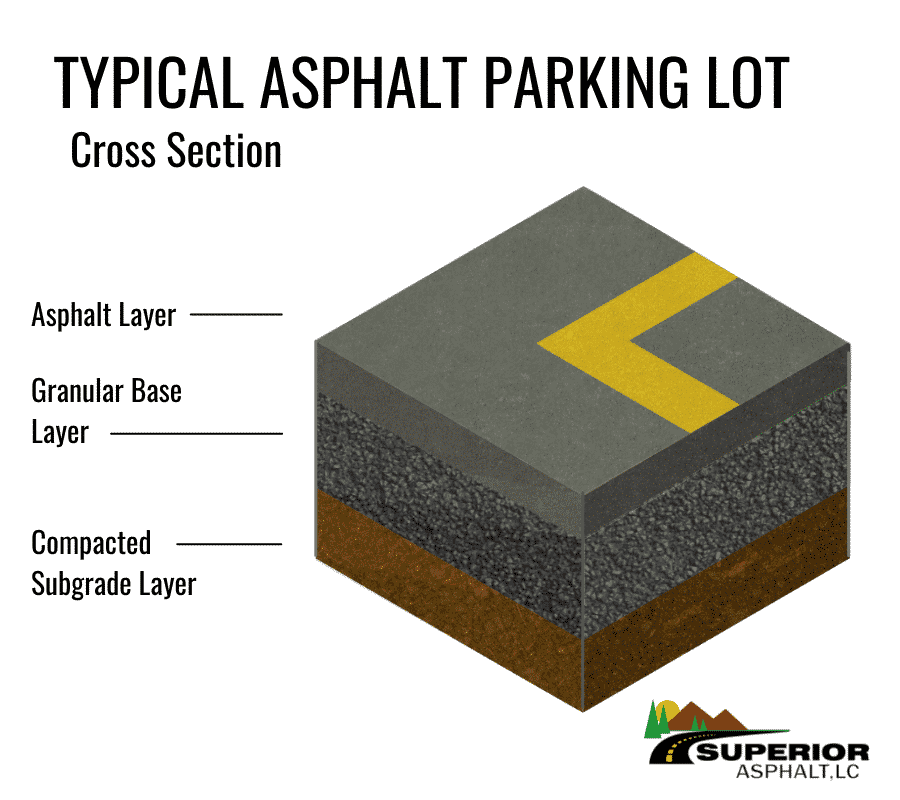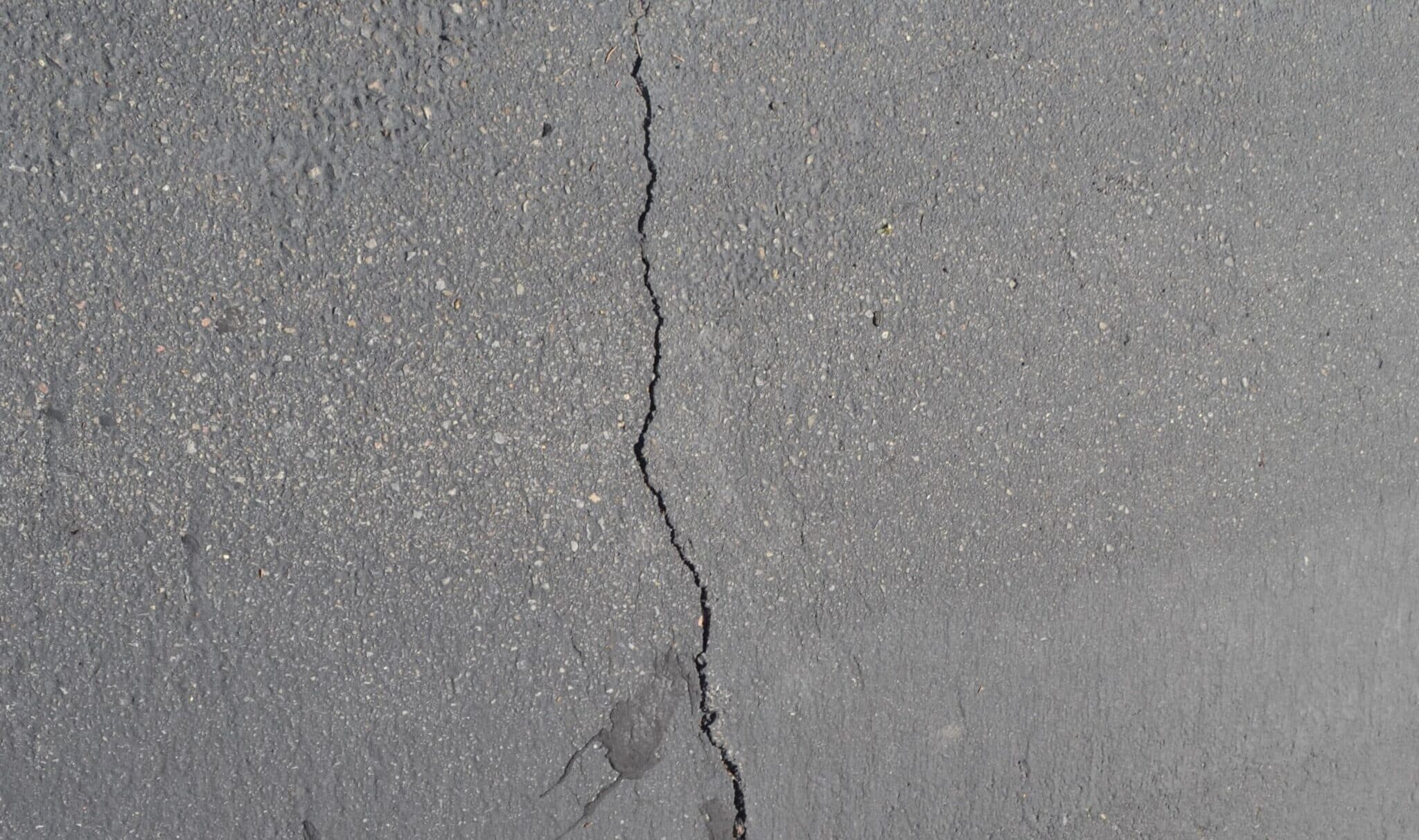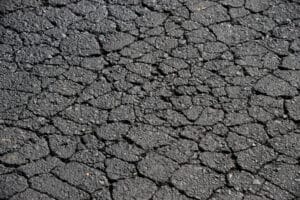There are many types of asphalt damage for property managers to worry about. Here’s why asphalt cracks should be at the top of the list.
Typical Asphalt Pavement Structure

Asphalt pavement is typically composed of three layers:
- Top/Surface Layer: Asphalt pavement
- Middle Layer: Granular base
- Bottom Layer: Compacted subgrade
Asphalt pavements are flexible. They are designed to deform without cracking when vehicles pass over them. They are also, for the most part, designed to expand and contract due to the sun’s thermal cycle. However, from the time new asphalt is laid, it starts oxidizing, making it more brittle.
Why Asphalt Cracks
Asphalt cracks when stresses push it further than it can handle. It’s only so strong and it’s only so flexible. That flexibility depends on several factors, including age, composition, and construction. Although there are many types of asphalt damage, there are just two main types of asphalt cracking, classified by their causes: fatigue and thermal stresses.
Fatigue/Alligator Cracking
Fatigue cracking, also known as alligator cracking, happens when the pavement can’t handle the stress of traffic load. This failure is often caused by improper installation or breakdown of the underlying layers of a driveway or parking lot. Base and subgrade can be washed away by water, leaving an empty space between the upper asphalt layer and its support. Without support from lower layers, asphalt fails with normal traffic. This manifests in a block pattern that looks a bit like alligator skin, hence the name — alligator cracks
Thermal Cracking
Asphalt expands and contracts with temperature changes, especially during extremes in the summer and winter months. When it contracts in the winter, sometimes it just isn’t flexible enough to stretch as much, and as quickly, as the ambient temperature requires. That’s when long skinny cracks form, generally perpendicular to the full length or width of your pavement. Thermal cracking is the first to happen in even well-laid pavement. It generally appears within 1 to 3 years.
When Asphalt Cracks Are Untreated
When left untreated, water, dirt, gravel, and more can get into cracks. The introduction of these elements into open asphalt cracks means trouble for the surrounding pavement. Neglecting crack sealing speeds up the breakdown of the adjacent pavement.
Once a crack opens, the most imminent danger is water, which can lead to asphalt raveling and loss of base. If water gets into the base, it expands and contracts with normal environmental temperature fluctuations. This causes the surface to rupture, forming potholes. Additionally, if water washes away the base, alligator cracking happens.
Cracks open up in winter when the asphalt is stretching to contract. But, when summer comes, asphalt naturally wants to expand back, closing the crack, due to warmer temperatures. If dirt and rocks have made their way into the crack, this expansion can’t happen. This causes more cracking.
Asphalt Crack Sealing
To avoid accelerating asphalt breakdown, you need to have cracks sealed.
Asphalt crack sealing is a regular part of asphalt maintenance. First, cracks are cleared of debris. Then, crack sealant material (heated to 350-400 degrees) is pumped through special hoses and injected into cracks. The material should bridge the full width of the crack, joining the two sides.
Crack sealant keeps water and other harmful elements out of the crack. This means that water doesn’t have the chance to enter through the crack and damage the sub base. It helps prevent further damage later on.
A small crack is not the worst thing when it comes to asphalt maintenance. Sealing cracks in the asphalt surface is less expensive than larger cut and replace asphalt repair needs. Its more cost-effective to seal cracks to avoid further cracks, potholes, and more extensive asphalt damage.
Read More: Asphalt Crack Repair 101, Cracked Asphalt: When to Seal vs Repair
3 Asphalt Crack Management Tips for Property Managers
As a property manager, you have a lot on your plate. Here are three pieces of advice:
#1) A Good Crack Seal Lasts At LEAST 1 Year
Sealing cracks is an ongoing maintenance process. Once you seal a crack, it will likely need to be sealed again. The flexible sealing material can withstand lots of things. But, when the seal breaks, it needs to be re-sealed. It’s standard to reseal cracks every 18 months to two years.
#2) Asphalt Cracks 1.5 Inches or Wider Are Too Big
If a significant footage of cracks reaches 1.5 inches or wider, traditional asphalt crack sealant won’t do the trick. There are treatments for larger cracks, but the larger the crack, the more damage.
#3) Find an Asphalt Maintenance Partner
Crack sealing is an ongoing need. Because of this, it’s common for administrators of school and business campuses, apartment complexes, and property management groups to partner with crack sealing contractors for ongoing seasonal parking lot maintenance.
Utah Asphalt Maintenance Services
If you are looking for an asphalt maintenance partner in Utah, Superior Asphalt, LC can help. We work with property managers and facilities managers to put together and service ongoing asphalt pavement management plans. Contact us for help with your asphalt maintenance needs.
More Superior Asphalt, LC Resources for Property Managers:





